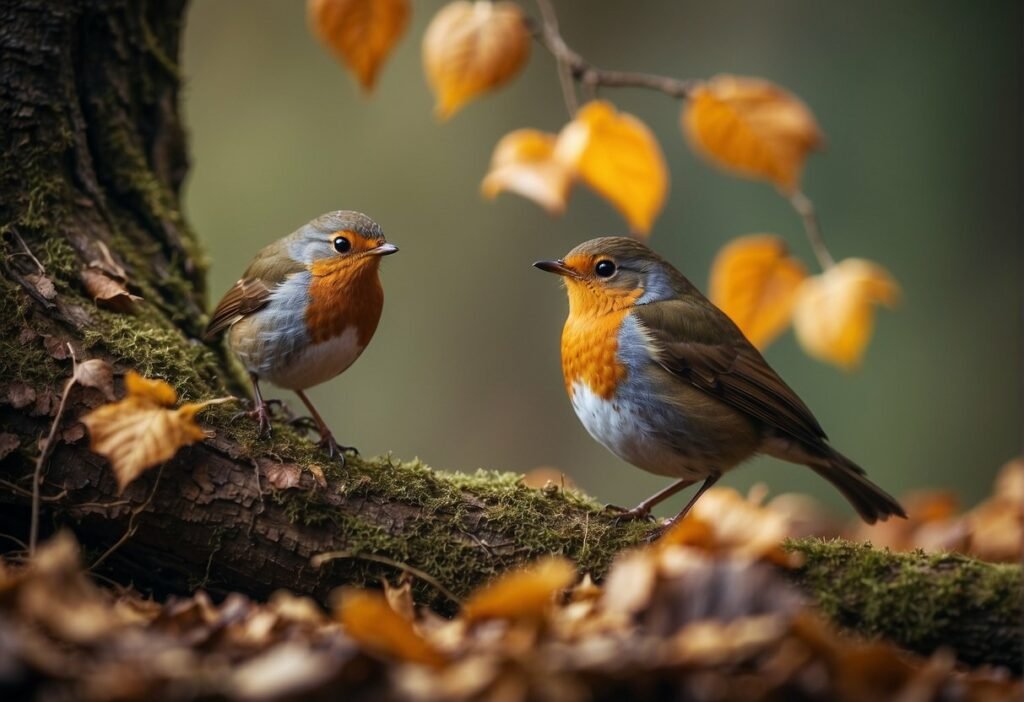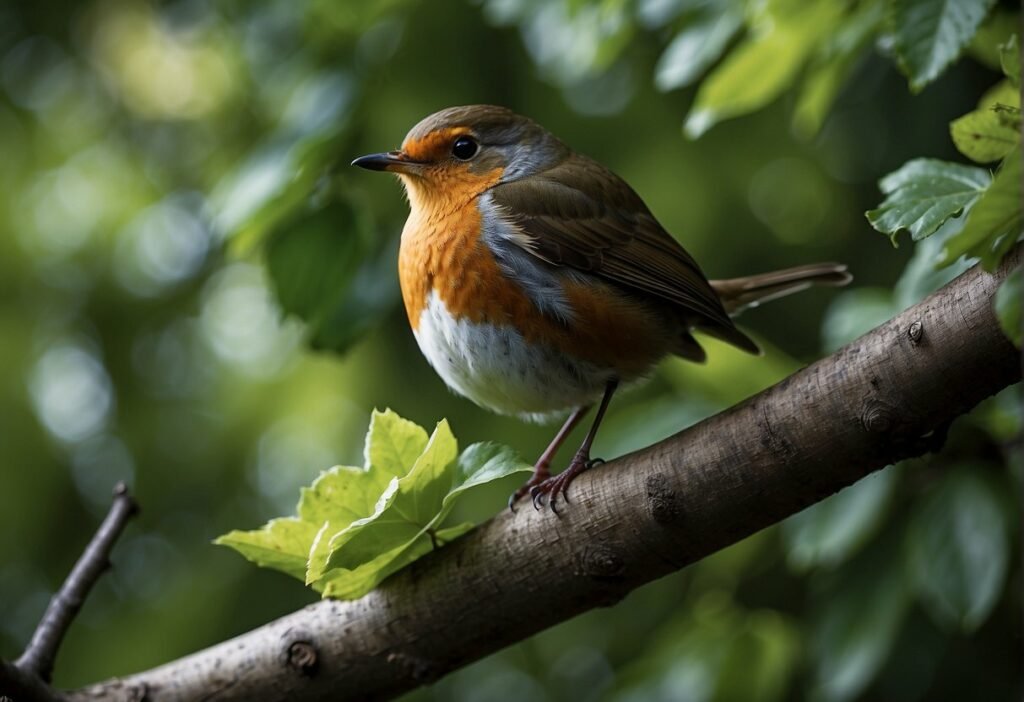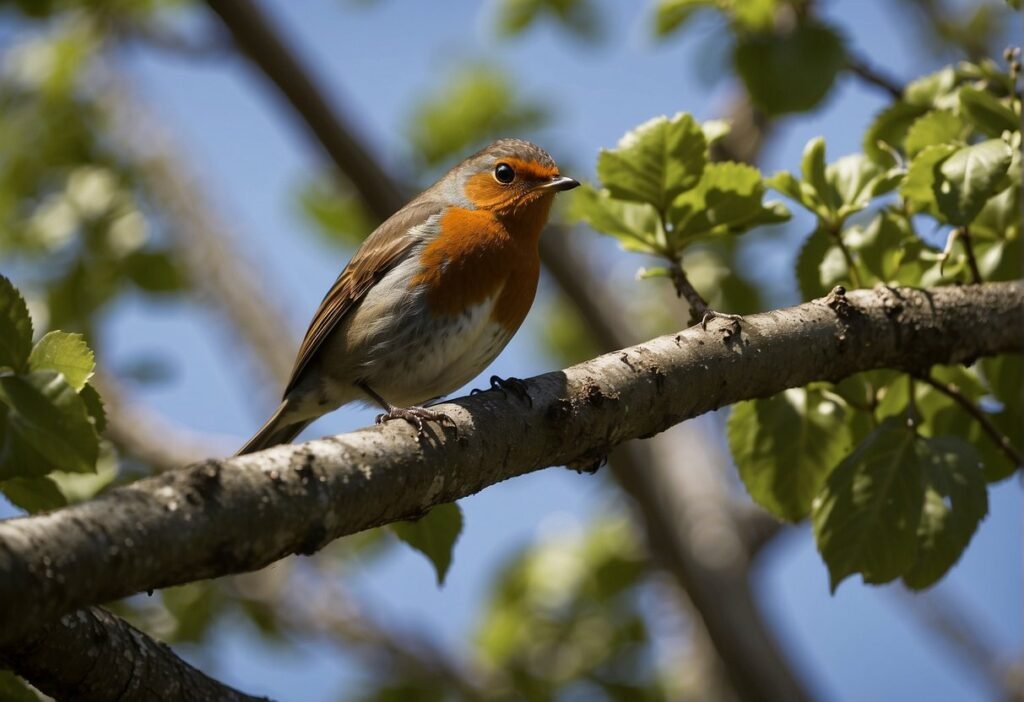The Mystery of Robin Blue Egg
The enchanting hue of robin egg blue has captivated observers for centuries. In this section, we dissect the science behind this color, its occurrence in nature, and its significance in the life of the American Robin.
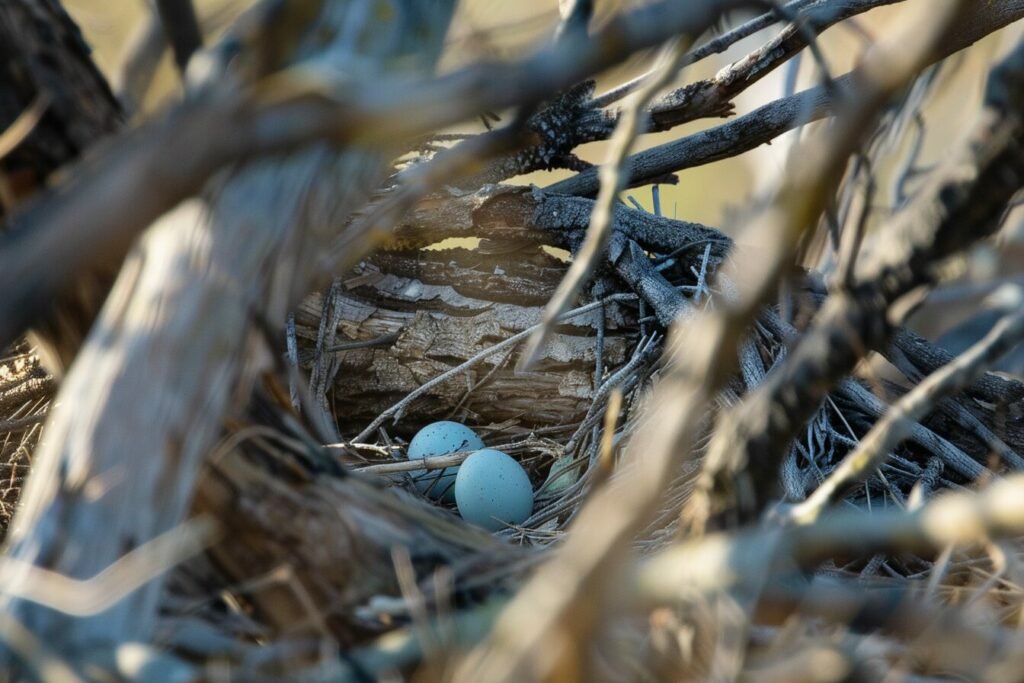
Biochemistry Behind the Blue
- Pigment Power: The blue of robin eggs comes from biliverdin, a pigment deposited on the eggshell.
- Eggshell Structure: The arrangement of biliverdin molecules within the eggshell layers influences the intensity of the blue color.
Diet and Egg Color
- Feeding Habits: Robins’ diets, rich in carotenoids, are linked to the vibrancy of their egg color.
-
Dietary Links:
- What Robins Eat: Insight into the dietary choices that may affect egg pigmentation.
Comparative Analysis of Bird Egg Coloration
- Avian Diversity: Bird egg coloration varies significantly among species, influenced by factors like diet, habitat, and evolutionary pressures.
-
Species Comparison:
- Bird Species Identification: Tools for distinguishing the American Robin from other birds by their eggs.
Table: Egg Coloration in Different Bird Species
| Species | Egg Color | Pigment Involved | Notes on Coloration |
|---|---|---|---|
| American Robin | Blue | Biliverdin | Linked to camouflage |
| European Robin | White with specks | Protoporphyrin | Adaptation to nesting sites |
| Common Cuckoo | Variable | Biliverdin, Others | Mimicry for brood parasitism |
The Significance of Color in Robin Eggs
- Camouflage: Blue eggs blend into the open sky and shaded nests, providing a measure of protection against predators.
-
Predation and Egg Color:
- Predators of Robins: Understanding how egg color helps in evasion.
- Parental Behavior: The color of eggs may signal parents about the health and status of their offspring.
Evolutionary Perspectives
- Natural Selection: The distinctive blue color may have been naturally selected for its benefits in survival.
-
Biliverdin Benefits:
- Antioxidant properties that protect the embryo.
- Signaling mechanism to indicate female health to potential mates.
By exploring the robin’s blue eggs through the lenses of biochemistry, diet, comparative analysis, and evolutionary theory, we gain a deeper appreciation for this natural wonder. The next section will delve into the reproductive habits and nesting behaviors that are integral to the life cycle of the American Robin, further unveiling the narrative behind their iconic blue eggs.
Avian Biology and Reproduction
Understanding the reproductive life of the American Robin provides insights into the significance of their blue eggs. This section will cover the nesting habits, mating patterns, and the factors influencing their reproductive strategies.
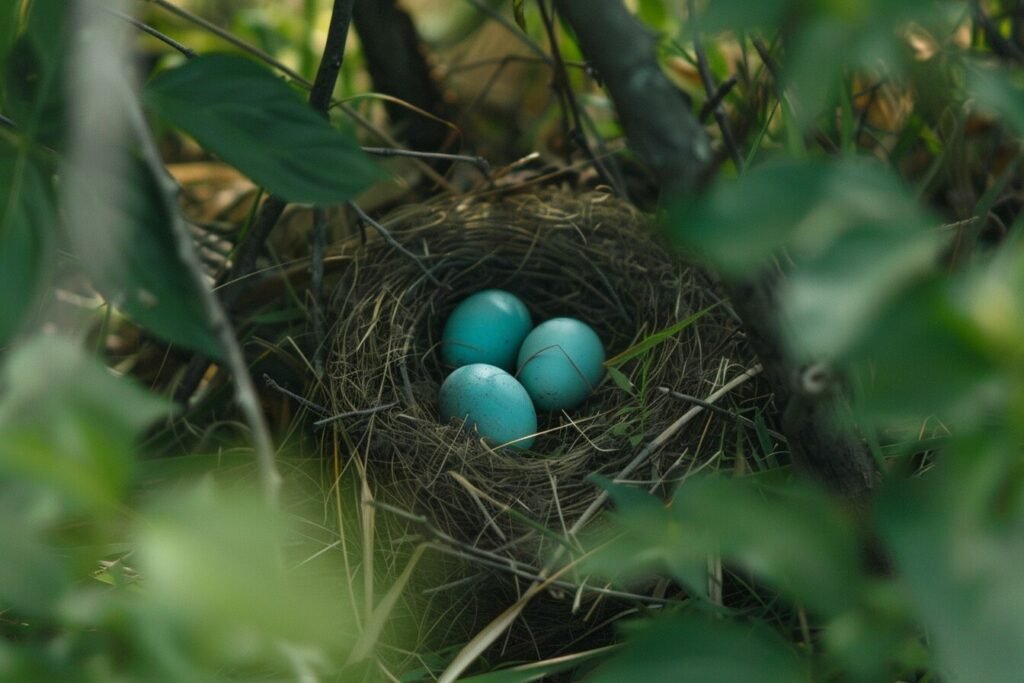
Nesting Habits and Habitat
-
Site Selection: Robins choose nesting sites that offer safety and proximity to food.
- Natural Habitats of Robins: Examines where robins thrive naturally.
- Making a Robin-friendly Backyard: Tips on creating a hospitable environment for nesting.
-
Nest Construction: Robins use twigs, grass, and mud to construct sturdy cup-shaped nests.
- Nesting Sites: A look into the robin’s criteria for selecting the perfect nesting spot.
Reproduction Cycle
-
Mating and Egg-Laying: Robins typically mate from April to July, with the peak of egg-laying in spring.
- Robin Mating Habits: Details on how robins attract mates and reproduce.
- Egg-Laying Period: Discusses the timing and conditions favorable for egg-laying.
-
Incubation and Hatchlings: The female robin incubates her eggs for about two weeks before they hatch.
- Lifecycle from Egg to Adult: Describes the developmental stages of robins from conception to maturity.
Parental Behavior
- Brooding Patterns: Female robins primarily handle incubation, with males often providing food.
- Protection Strategies: Both parents are known to be fiercely protective, often engaging in diversion tactics to lead predators away.
Table: Reproductive Timeline of the American Robin
| Stage | Duration | Activity |
|---|---|---|
| Nest Building | 2-6 days | Gathering materials and construction |
| Egg Laying | 1 egg/day | Typically laying a clutch of 3-5 eggs |
| Incubation | 12-14 days | Female warms the eggs until hatching |
| Fledging | 13-14 days | Young robins grow and prepare to leave nest |
| Independence | Approx. 2 weeks after fledging | Juvenile robins start feeding themselves |
Understanding the avian biology of the American Robin provides context to the function and beauty of their blue eggs. In the next section, “Evolutionary Biology of Egg Coloration,” we will delve into the adaptive significance of egg coloration in relation to environmental pressures and survival strategies.
Evolutionary Biology of Egg Coloration
In the realm of evolutionary biology, the coloration of a robin’s egg is not merely a matter of chance. It is a product of complex adaptive processes shaped by environmental pressures and survival needs. This section explores the evolutionary underpinnings of why robins’ eggs are blue.
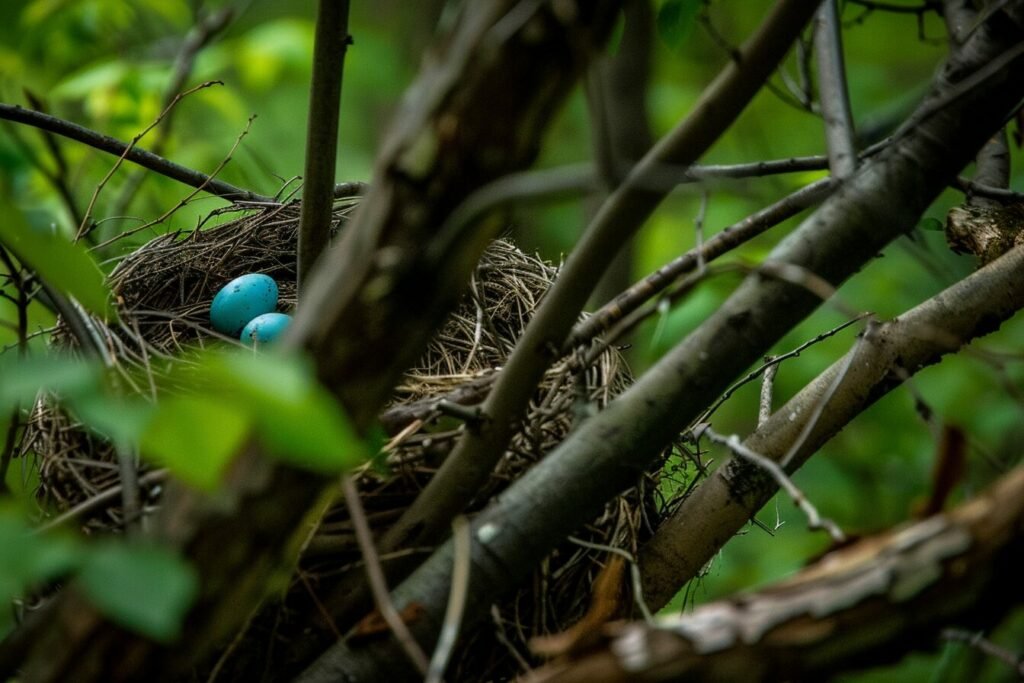
Adaptive Significance of Biliverdin
- Antioxidant Properties: Biliverdin, the pigment responsible for the blue color, has been found to have antioxidant properties that may protect the embryo from oxidative stress.
- Female Health Indicator: The presence of biliverdin in the eggshell might also act as a signal of the female’s health and genetic quality to the male robin.
Evolutionary Theories on Egg Coloration
- Camouflage Hypothesis: The blue color may have evolved to provide camouflage against predators, blending the eggs with the sky and surroundings.
- Sexual Selection: The color might also be a result of sexual selection, where females with bluer eggs have a selective advantage.
- Brood Parasitism Defense: The distinct coloration could help robins recognize and reject parasitic eggs laid by species like the brown-headed cowbird.
Environmental Influences on Egg Color Evolution
- Habitat and Nesting: The color of robin eggs may have evolved in response to the specific lighting conditions of their preferred nesting sites.
- Predation Pressure: The intensity of predation in an area can influence the natural selection for egg coloration.
- Climatic Factors: Regional climate variations have been proposed to affect the evolution of eggshell color and thickness.
Table: Evolutionary Influences on Egg Coloration
| Factor | Influence on Egg Coloration |
|---|---|
| Oxidative Stress | Selects for antioxidant properties in pigments |
| Mate Attraction | Favors more vibrant egg colors |
| Nesting Site Characteristics | Influences adaptation for better camouflage |
| Predation | Drives natural selection for survival traits |
| Climate | Affects the robustness and color of eggshells |
The blue of a robin’s egg is not just a visual treat; it’s a narrative of natural selection and the bird’s ecological dance with its environment. In “Section 4: Environmental Factors Influencing Egg Color,” we will explore how current environmental conditions may continue to shape the coloration of robin eggs.
Environmental Factors Influencing Egg Color
The color of a bird’s egg is not only a result of genetic inheritance and evolutionary history but also a reflection of current environmental conditions. This section examines how various environmental factors can influence the coloration of robin eggs, emphasizing the dynamic nature of this avian characteristic.
Impact of Diet on Egg Coloration
- Nutritional Availability: The abundance and variety of food sources, including the insects that robins eat, can affect the concentration of pigments like biliverdin in the eggshell.
- Seasonal Variations: Changes in diet due to seasonal availability of food can lead to fluctuations in egg color intensity from one clutch to another.
- Environmental Toxins: Exposure to environmental pollutants can potentially alter the chemical composition of egg pigments, influencing color.
Role of Urbanization
- Light Pollution: Increased light in urban areas may affect the way egg colors are perceived by predators and robins themselves, potentially influencing the evolution of egg coloration.
-
Altered Ecosystems: As robins adapt to urban environments, the resulting changes in nesting materials and locations can impact egg color.
- Robins in Urban Environments: Discusses the adaptability of robins to city life.
Climate Change and Egg Color
- Temperature Effects: Warming temperatures could influence the rate of pigment deposition on the eggs or alter the chemical stability of pigments.
- Weather Patterns: Extreme weather events may stress robin populations, affecting the female’s ability to deposit consistent pigment levels.
Table: Environmental Factors and Their Potential Impact on Egg Color
| Environmental Factor | Potential Impact on Egg Coloration |
|---|---|
| Food Source Quality | May influence pigment intensity |
| Urbanization | Could alter pigment composition |
| Climate Change | Might affect pigment stability |
| Seasonal Changes | Leads to variations in coloration |
The interplay between environmental factors and egg color showcases the robin’s remarkable ability to respond to its surroundings. Such adaptations underscore the importance of understanding how changes in our environment could shape the future of wildlife species.

